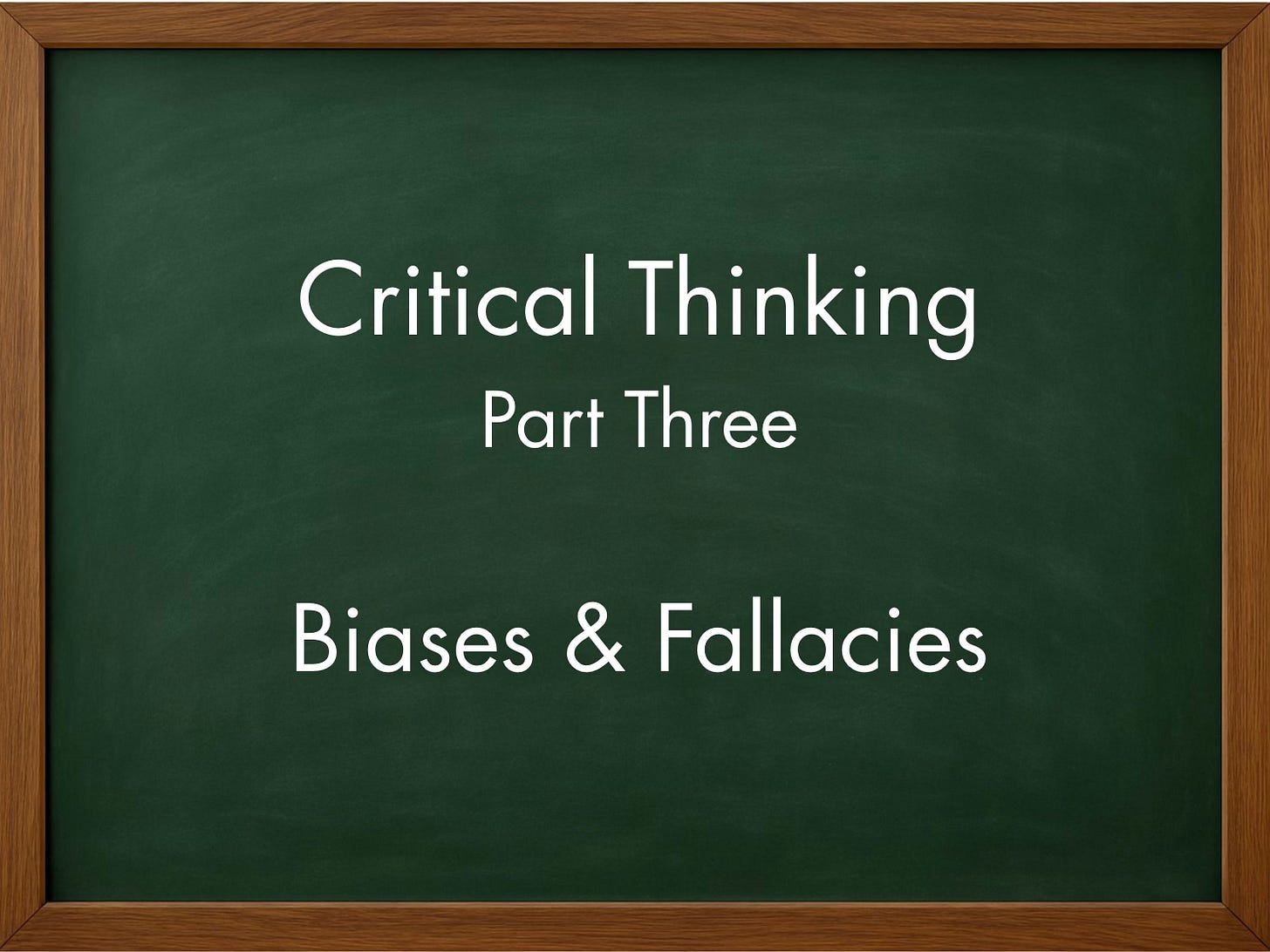Part Three: Biases and Fallacies
Critical Thinking
Biases & Fallacies
Metacognition is simply thinking about and regulating your thinking. You can do this by asking yourself questions such as:
What assumptions might I be making?
What am I basing my judgement upon?
How am I rating the evidence?
These kinds of questions can help to highlight personal biases which you may not have been previously aware of and which may influence your judgement.
Why This Matters
Making the effort to use and apply our metacognition when needed can slow our automatic responses long enough to allow us to engage our own powers of deliberate appraisal. This conscious engagement gives us the opportunity to use our discernment and our critical faculties.
A bias is a systematic disposition in how we attend to, recall, and evaluate information. It is about how the evidence gets selected, weighted and framed.
Here is a short list of the most common biases although there are many more:
Confirmation Bias: Favouring information that supports preexisting beliefs.
Anchoring Bias: Over-reliance on the first piece of information encountered.
Availability Heuristic: Assessing likelihood by how easily examples come to mind.
Hindsight Bias: Thinking that past events were more predictable than they really were.
Dunning-Kruger Effect: Below average performers have a tendency to overestimate their abilities. Conversely, above average performers have a tendency to underestimate their abilities.
Brown University has a very nice and helpful cheat sheet
Fallacies
A fallacy is an error in reasoning. They fall into two groups; formal (structural), and informal (relevance, ambiguity, etc.)
Formal Fallacies
Affirming the Consequent: If it rains, the roads are wet. The roads are wet, so it rained. (Not necessarily. There may be another reason for the roads being wet.)
Denying the Antecedent: If it rains, the roads are wet. It didn’t rain, so the roads aren’t wet. (Not necessarily, the roads could still be wet for other reasons.)
Undistributed Middle: All cats are animals. All dogs are animals. Therefore, all dogs are cats.
Illicit Conversion - All A are B: All poets are dreamers; therefore all dreamers are poets. (Invalid switch around.)
Informal Fallacies
Straw Man: Misrepresenting an opponent’s view. Instead of the claim itself being attacked, argumentation is aimed at a weaker, distorted version.
Ad Hominem: Attacking the person rather than the claim.
False Dichotomy: Treats a complex issue as an either/or choice ignoring viable alternatives.
Slippery Slope: Asserting without adequate evidence that a small first step will inevitably lead to a particular chain of outcomes.
Circular Reasoning or Begging the Question: An argument that assumes its own conclusion in the premises.
Post hoc ergo propter hoc: The assumption that because B follows A, A must have caused B.
Appeal to Authority: Treats a claim as true, without qualified support, just because it came from an authority. However, appeals to relevant, expert consensus can be reasonable if there is supporting evidence.
Appeal to Emotion: This technique plays on fear, pity, or sentiment instead of reason.
Red Herring: Attempts to divert attention to something irrelevant to avoid the real issue.
At the Internet Encyclopedia of Philosophy they have a handy list of more than 200 fallacies to sift through.
The canonical book to read and more learn about how deeply we are affected by biases and fallacies is Thinking, Fast and Slow by the late Daniel Kahneman.
In the introduction to the book he says this, “Systematic errors are known as biases, and they recur predictably in particular circumstances.” This is good news for us as bias and fallacies are not the products of the fickleness of fate. They are patterns within our thinking processes that once we are aware of, we can factor into our analysis of a claim.
Since learning about biases and fallacies is fun and illuminating I have included some more.
Confirmation Bias: Searching for, selectively noticing, and recalling evidence that supports your existing belief while dismissing evidence that challenges it.
Motivated Reasoning: Seeking, interpreting, and weighing information so you reach the conclusion you prefer.
Base-rate Neglect: Ignoring how common a thing is.
Selection Effects: The data you see may not represent the data that exist.
Fallacies of which to be Particularly Wary
Motte and Bailey: Shifting between a bold, controversial claim (bailey) and a narrow easily defended version of the claim (motte) when challenged. It is often used as a rhetorical tactic.
Equivocation: Using the same word with different meanings within an argument.
Moving Goalposts: After evidence meets the agreed standard, the standard is raised or changed to avoid accepting the result.
Texas Sharpshooter: Drawing the target after you’ve fired. Cherry-picking data after the fact.
No True Scotsman: Redefining a category to exclude counterexamples.
Sunk-Cost Fallacy: Clinging to an idea or strategy, because you have invested so much time, energy, or money already. This also can be viewed as a decision bias.
These are links to the other parts of this critical thinking series:
Part One: Analysing the Claim
Part Two: Inference and Evaluation
Part Three: Biases and Fallacies
Part Four: Challenging a Claim
Part Five: Practical Tools
I have also written a primer covering the basics of critical thinking and you can download a free PDF copy here at my personal website tommurphy.me



